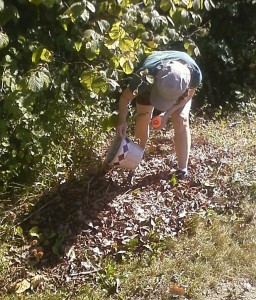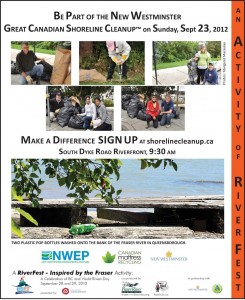I noticed this blog has been full of bummers and whinging lately (“lately?”), so I wanted to give a shout-out to a good news story here in New West.
The Great Canadian Shoreline Cleanup is an annual nation-wide event, where various volunteer groups adopt a stretch of shoreline near their homes and (as the name suggests) clean them up. There have been off-and-on shoreline cleanups in New West, mostly organized by Scouts or Businesses, but last year was the first NWEP-sponsored “public” clean-up. You didn’t need to belong to a club or a business, or even the NWEP: it was just a drop-in on a Saturday. It was organized with remarkable fervour by NWEP member Karla Olson.
The stretch of shoreline chosen for cleanup was the recently-refurbished stretch of South Dyke Road between the Boundary Road and Derwent Way, in sunny Queensborough. The stretch of shore has a combination of multi-use paths, dock features, and walking trails that make the most of the waterfront, so keeping it clean seemed like a great community-building idea for the relatively new neighbourhoods in southern Queensborough.
Last year, there was a bit of a panic, as it seemed there wasn’t really all that much trash – so Karla was a little concerned her volunteers would make the effort to show up, and have little to do – so she added a small invasive plant pull at the same time. A patch of Japanese Knotweed was crowding out native plantings by one of seating areas, and a patch of English Ivy was threatening to choke out a Douglas Fir right on the waterfront. With some help from the City on New Westminster and a volunteer expert on invasive plant management (who happens to be married to the new Royal City Farmers Market Operations Manager), a plant pull and disposal was organized.
Turns out, litter is the kind of thing that surprises you once you start collecting it. Karla’s fear (optimism? ) was unrealized and the volunteers who showed up collected an ample amount of trash. They also took a real bite out of the Japanese Knotweed patch and the English Ivy climbing the tree. Karla’s organization skills came to the fore, the 30-odd volunteers had a great time, and made a difference in the local community.
This year, the Shoreline Cleanup is back for more on September 23rd. With more people using the waterfront trails, and lots of jetsam brought to shore by the high freshet this spring, the (now annual) event will probably see more trash this year than last. They are also hoping to see more volunteers as well – which is why the “Invasive Plant Pull” part of the program is expanded this year.
If you haven’t been involved in a plant pull before, here is the quick background. There are several species of plants considered “invasive” in BC- not just because they come from other continents, but because they are safe from their natural emnemies (predators, insects, weather) and without these controls, they can take off – even displacing the native plants and threaten the native habitats of plants, bugs, birds and other animals. Most are bought as ornamental plants, and go “feral” when someone throws yardwaste or plant pots into the woods – to “give the plants their freedom”.
 |
| A “Feral Potted Plant” found on South Syke Road during plant tagging. |
During last week’s invasive tagging event, we found lots of morning glory , some wrapping itself around and choking out native snowberry plantings; a couple of Scotch Broom plants; resdiual English Ivy from last year’s pull; and English Holly, which is merry at Christmas, but invasive in the wild, displacing the similar but native Oregon Grape. All of these will be targeted during the plant pull part ofthe Shoreline Cleanup.
The Japanese Knotweed that was knocked back last year has started to come back, but now that it its weakened, the City can come back and do stem injection to kill off the remainders, before the roots undermine the dike. And then there is the Himalayan Blackberry, a nasty (but tasty!) invasive that has become so ubiquitous, that eradication seems a distant dream. It is also a mean, spikey plant that is probably best managed by people wearing thick clothing and safety glasses.
So if you want to help out for an hour or two, you can collect trash, or you can get a little bit more involved taking out some invasive plants – you might even learn a bit about what plants are native and which are invasive – once you can identify a few species, you start seeing them in other places. Most importantly, you can meet some people in the community interested in protecting the shoreline, and be part of a nation-wide campaign.
No pressure, no long-term commitment, just a family-friendly day helping out in the community.
It’s best if you sign up ahead of time, by clicking here. you can also just show up, but if you bring the kids or are under 19 yourself, you need a waiver signed by a Parent or Guardian, which you might want to get done ahead of time (you can get the waiver on the website, and bring it with you).
The shoreline is muddy at low tide, so you might want to wear boots or rugged footwear. Long sleeves and pants are a good idea for pulling invasives and for picking up trash (the City of New West will provide gloves for voulunteers – but you can bring your own), and there will be a few tools available, but feel free to bring your own clippers, loppers, garbage pickers, etc. Bring some water and snacks, as the event will probably go on for a couple of hours – just remember to pack out your wrappers!
The Event is on September 23 , starting at 9:30 AM. Folks will meet on South Dyke Road, near where Suzuki Street meets it – you should see the tents there, a couple of blocks east of Boundary Road, as far south-west in New Westminster as you can be!
